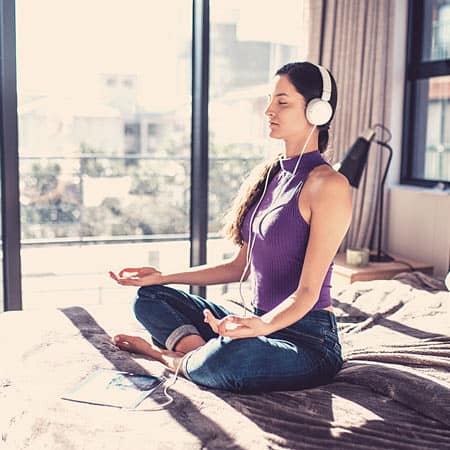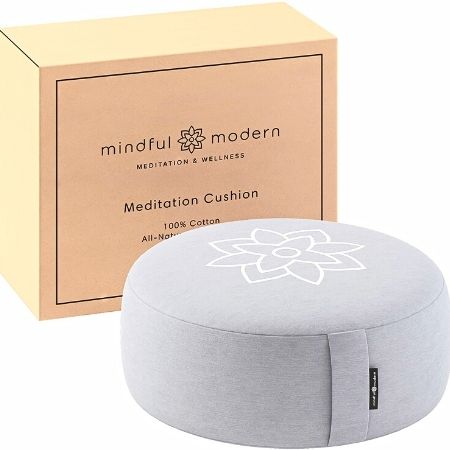When introducing meditation into our lives, it can be challenging to merge this peaceful, relaxing practice with our hectic lifestyles. In our society, we all tend to work as much as we can and do something at all times. However, meditation encourages stillness and introspection—states that it can be challenging to achieve without proper focus.
To meditate without losing focus, find a safe place and a comfortable position. Use props such as pillows, and opt for guided meditation practices. If you are new to meditation, starting with short sessions and using breathing exercises can help. With practice, your focus will improve.
Remaining focused can help you meditate for longer, which, in turn, can yield more significant benefits to your daily life. Learn how to concentrate for longer and reach deeper meditative states below.
Meditation and Focus: What Are the Challenges?
Before diving into the techniques you could use to increase your focus while meditating, it is crucial to understand why this might be difficult for practitioners. Losing focus too quickly is something that can put meditators off, especially beginners. Also, without consistency and practice, meditation won’t yield the benefits you had been hoping for.

One of the most significant challenges when trying to increase our meditative focus is fighting the urge to do something, make plans, and move our bodies. These are engraved behaviors often related to the society we live in.
Indeed, from a young age, we are all taught to give our best at all times and take only the rest we need to be even more productive during our lives. This attitude causes meditators—especially beginners—to feel restless and guilty. These feelings arise because we are all taught that we should always be filling our time with “useful” tasks and chores.
In turn, it is not uncommon for practitioners to keep thinking about the tasks they need to accomplish, their meetings, and appointments—this is normal! However, it can get in the way of your practice and make you feel not as relaxed, regenerated, or peaceful after your meditation session.
Another two leading causes for your focus level to dip during your meditation session are the average attention span and distractions (including thoughts and feelings).
The Average Attention Span
The human attention span is something that can feel limited. The average attention span for adults is somewhere between 10 and 20 minutes.
However, there are different levels of focus that we can enter and maintain. The ones we commonly practice in our daily lives are:
- Sustained attention: The ability to concentrate on one task for long time frames without falling for distractions.
- Selective attention: The ability to focus on one factor or feeling that we choose, filtering out all other distractions and stimuli.
Both types of attention are crucial for successful meditation practice. At the same time, meditation can increase your attention span and ability to focus.
However, if you are struggling to create a balance between the two, other methods can help you improve your attention span in your daily life—a skill that you can then apply to meditation:
- Practice active listening: Listening actively, without interrupting, and while controlling your body language.
- Spend more time reading: Reading for 20 to 30 minutes without using your phone or watching TV can help you increase your attention span.
- Relax your muscles: Begin to practice mindful exercises such as yoga or jogging.
- Avoid multitasking: Multitasking causes your brain to switch from an action or thought to another, preventing you from focusing on one stimulus at a time.
- Spend time in nature: Spending more time in nature can help your muscles relax and regenerate, offering fresh oxygen to the brain.
Feelings and Thoughts
Meditation is a potent practice that can yield impressive benefits in our daily life. Researchers from Harvard have shown how meditation can change the brain’s structure, creating new pathways and channels. In turn, such drastic changes can improve our life’s outlook.
However, such a profound practice can also steer up feelings, memories, and emotions that will resurface after being buried for months or years. Depending on your goal, you might even experience painful or overwhelming feelings during your meditation practice.
It is entirely normal for such powerful emotions to arise during meditation—it is part of the process of accepting what you feel and overcoming it. Over time, and with practice, you will be able to keep such feelings at bay. However, you should expect them to arise during your first practices. Acknowledge this and bring your mind back to your body or your breath.
Now that you know what distractions to expect let’s look at keeping your mind and body focused for longer during your next meditation session.
Create a Space Where You Feel Safe

When you practice meditation, your mind and body will be prompted to adapt to a new state of not doing anything aside from breathing. Allowing yourself to stand still for several minutes can bring many individuals out of their comfort zone.
Therefore, it is normal to feel unsafe or overwhelming, especially as you use your actions, words, and awareness to keep yourself protected during your daily life. Practicing meditation involves bringing your awareness inwards rather than outwards, meaning that you might feel exposed. As a result, while meditating, you might feel that danger or interruption is always around the corner.
Naturally, you can practice meditation anywhere, including during your commute or while waiting for an appointment. However, creating a safe meditation space at home or the office can help you.
You can do so by carving a corner in your room, adding pillows and a comfortable seat. Having full control over the surrounding environment before entering your meditation session can help you eliminate from your mind the thought that something might happen, interrupting you, startling you, or putting you in danger.
Creating the Perfect Meditation Environment
When creating the perfect meditation environment, some golden rules can help you get rid of most guesswork. Here are the ones suggested by NLP Practitioner and hypnotist Benjamin Bonetti:
- Pick a room without any electronic gadgets (phones, TV, computers, etc.).
- Be mindful of the lighting. Bright lightbulbs and flickering lights might represent a distraction. Opt for an environment with natural light if possible.
- Make sure noise is limited to a minimum. Noises can be distracting and startling.
- Make sure the room has a smell or scent that is compatible with your sense of relaxation. You might decide to light a candle or burn incense.
Some meditators also like the idea of meditating outdoors. This choice can make the meditation special, but it is not recommended for beginners, as there can be many distractions, including noises, scents, and other stimuli.
Use Props That Can Help Increase Comfort
Finding a spot where you can feel comfortable and safe is not as easy as it looks, and you might need to try different corners and locations before finding the right one. However, some props can help you make a spot more comfortable.
Some props include:
- Earplugs: If you have found the perfect location but it is noisier than you would prefer, opt for earplugs. However, it is very important that you don’t get used to using them all the time, as, in the long term, it will not benefit your practice.
- Headphones: Headphones, especially if noise-canceling, allow you to cut out any noise that might be startling or disrupting. They might also be useful if you prefer to listen to relaxing music while meditating.
- Blanket: When meditating, your heart rate and breathing slow down, and your body will come to stillness. So, it is not uncommon for you to feel colder, and having a blanket can prevent you from interrupting your meditative state.
- Meditation pillow: Meditation pillows can help you correct your posture, feel more comfortable, and remain in a meditative state for longer.
Find a Comfortable Position
If you are approaching meditation, you will find that there are several misconceptions to fight. Perhaps, one of the greatest ones is that you can only meditate while sitting cross-legged, with your eyes closed, and while holding a mudra.
While this position is part of the imagery associated with meditation, it should not stop you from meditating in a position that feels comfortable.
Indeed, only a minimal number of individuals will feel comfortable sitting cross-legged on the floor because of our lifestyle. This position can cause tingling, pain, and a numbing sensation in the legs for most of us. Additionally, it can cause our spine to curve forward, causing us to lose alignment and proper posture.
If you have picked a position in which you don’t feel entirely comfortable, you will need to move and interrupt your meditation session earlier than planned.
When approaching meditation, make sure to meditate in different positions to understand which one feels more comfortable and natural to you. Some of the most common ones include:
- Sitting on a chair: Make sure your feet’s soles are on the floor, your spine is straight, and your limbs relaxed. Release any tension you might be holding in the shoulders and jaw while finding a slight lift of the heart space.
- Lying down: You can meditate in Savasana or while lying down with your knees bent and a pillow under your head. However, in this position, it can be more challenging to keep focus.
- Standing meditation: You can meditate while standing or, if you are familiar with yoga, in Mountain Pose (Tadasana). Keep your knees soft, your spine and hips relaxed, and your feet hip-distance apart.
- In motion: You can also meditate while running or walking.
Resisting the Urge to Move
If you practice meditation in a still position, remember that this practice is all about finding peace, relaxation, and comfort in stillness. The moment you start to move and bring your attention away from your breath and into the performing movements, you will most likely lose your focus.
If a part of your body feels uncomfortable or you feel the urge to adjust, bring your mind and breath into that part of your body. This practice will help you relax that body part and clear it of any discomfort.
Addressing Physical Pain
As seen above, meditation has endless benefits, and it also has the power to change some pre-formed pathways in our minds. However, this potent practice also causes some effects in our bodies that we don’t know about or fully understand.
For example, it has been seen that meditation interacts with physical pain. This practice can help you bring your focus to something that your body is feeling, analyzing it, and starting to find a solution. When regularly practiced, meditation can relieve symptoms of aches and pains.
However, meditation also influences the way we react to pain. So, when feeling pain during meditation, you might start to bring your attention to it rather than turning away from what your body feels.
Meditate in the Morning (and Make It a Routine!)

Studies have shown that our brain is larger and at its most powerful in the morning and tends to shrink during the day—then returning to its size the next morning. This is not the only reason why meditating in the morning is the most effective way to bring this powerful practice into your daily life.
When meditating in the morning, you can make sure that you always make time for your meditation session. Whether you are only practicing for 10 to 20 minutes, a morning session allows you to keep up with your mindfulness goals.
Additionally, meditating in the morning allows you to practice without the weight that the day ahead can bring to your body and mind. Indeed, in the evenings, you might feel overwhelmed with all of your daily tasks and tired. These factors might influence your mind, decreasing your ability to focus and remain concentrated during your meditation session.
Lastly, meditating in the morning is a great way to bring mindfulness into your day. Indeed, meditation can help you feel more relaxed and allow you to work on your responses to daily events and interactions. With short morning meditation sessions, you can bring this mind-frame into your everyday life, keeping stress at bay.
Keep a Goal or Intention in Mind
Depending on the kind of meditation you are practicing, you might decide to focus on your breath, body, a particular stimulus, or goal.
When practicing meditation, many practitioners might discourage you from having a precise intent, such as “I will pass the exam” or “I will obtain a promotion.” Indeed, setting such intentions for yourself might cause you to raise the expectations you have for yourself and to start to strategize and make plans.
In turn, setting expectations might increase your daily stress when trying to achieve them. Instead, you should decide to set intentions for your practice or the day ahead. Setting intentions will give your day a theme to stick to. In turn, this will lead to the manifestation of your intention and increased awareness of the daily actions you take
When setting an intention, focus on actions or thoughts for which you are responsible—not others. Additionally, don’t put your expectations for an action that will happen. Rather, focus on how you want to feel during the day and the mindset you wish to keep while facing daily challenges and obstacles.
Some examples of intentions for your meditation practice are:
- I manifest happiness and courage.
- I lead by example.
- I bring happiness to my community.
- I forgive others and myself.
Create intentions that feel right for yourself. You can use them as a mantra or repeat them in yourself during your meditation to maintain focus.
Explore the Different Types of Meditation
If you have been practicing a type of meditation for a while, and you can’t focus, this type of meditation might not be the one that is suitable for your needs. Indeed, your mind and body might call for a more convenient alternative for your lifestyle right now and for the goals that you wish to achieve through daily practice.
Some of the types of meditation you might consider exploring in your next sessions include:
- Spiritual meditation
- Mindfulness meditation
- Movement meditation
- Visualization
- Chanting meditation
- Mantra meditation
- Transcendental meditation
- Sound bath meditation
- Yoga or Qigong
There are also many other types of meditation that are linked to religious traditions and beliefs. Picking the right kind of meditation for your body is the best way to tap into your ability to focus for extended time frames.
Indeed, for many practitioners, the option to repeat a mantra or use a chant allows them to keep meditating for longer and experience even more significant benefits. If you would like to focus on a sound, the sound bath meditation and singing bowls might be suitable options.
Using Guided Meditation
Guided meditation is among the best ways for beginners to approach this practice. Indeed, it is possible to find endless types of recordings and options for you to start practicing.
During a guided meditation, the voice of a guru, mentor, or meditation expert will guide you through each step of the process. When selecting the right kind of meditation for your needs, you should consider three main factors:
- The goal of that meditation practice
- Its length
- The type of meditation
For example, you might opt for a recording that aims at relaxation or focus. You might also pick a guided meditation that will show you how to perform successful visualization or a body scan.
There are several benefits of opting for a guided meditation session rather than a free one. Some of these include:
- You won’t need to worry about going over the time you had to meditate and be later for your appointments.
- You can follow the instructions prompted by the recording and respond to hints, so you will always know the next step.
- Listening to the recording will allow you to explore your meditation practice even further and help you concentrate.
- You can practice with a goal in mind.
- You can pick the type of recording more suitable to your needs.
Guided meditation recordings are available everywhere, on websites such as Insight Timer, Headspace, or even on YouTube. However, if it is safe to do so, you might also join groups of meditators and follow the guided meditation offered live by a mentor or guru.
Start With Brief Sessions
Struggling to keep your focus and attention during your meditation practice can be extremely frustrating for all practitioners. However, it is essential to understand that you don’t necessarily have to learn to hold your focus for hours at a time to consider yourself a meditator.
Indeed, studies have shown us that even brief sessions of 10 to 15 minutes every day can have incredible effects on our mind and body. Such short meditation sessions might be everything you needed to increase your level of attention, lift your mood, and have a more compassionate outlook on life.
So, if you struggle to keep your mind anchored to one place for longer timeframes, there is no need to worry. Start with brief meditation sessions that can bring you all the benefits you had been looking for. If you are still looking for some more guidance, you can find plenty of guided meditation sessions that can fit these short timeframes.
Don’t Get Discouraged if Your Mind Wanders

When practicing meditation, it is normal for your mind to wander, and it does not mean that you have to end your meditation session and try again. Many practitioners get discouraged if their thoughts wander to what to cook for dinner or to the next meeting to attend.
However, a wandering mind is something that we all have and deal with when meditating—it does not make you any less of a meditator. However, during your practice, when you notice that your mind is going further from your body or breath, consciously decide to bring it back to it.
The more you practice this exercise, the more your mind and body will become used to meditation, and with time, you will notice that you will need to bring your mind back to your breath or body less often.
However, it is crucial to keep in mind that each meditation session is unique. Therefore, even after months of practice, you might notice that you struggle to keep your attention one day. Such eventuality might be a consequence of something that is happening in your life or a stressful event.
In this case, it is crucial to steer off the temptation of judging yourself and your practice. Return to it once your mind is clear, and enjoy what you can do today!
Practice Mindful Exercise
Exercise is so important for our health and can significantly improve our meditation skills. Just like meditation, exercise releases endorphins, but it can also help you increase oxygen flow to the muscles and brain. Because of it, you will find it much easier to relax, control stress, and concentrate.
In turn, this will make it easier to hold onto your focus while meditating.
If you are not into lifting weights or running, opt for yoga flows. Yoga encourages moving with your breath and becoming more aware of your body—features that it shares with meditation. However, yoga can also help you become stronger, more flexible, and more stable—all skills that can help you increase your physical health.
Don’t Compare Yourself to Others
Every meditation session is unique, and no two meditators will experience the same feelings and thoughts when meditating. So, even if you have been practicing with a buddy, partner, or group, don’t compare your practice to theirs.
Each person might start meditating for different reasons: someone might want to control stress levels, while others are looking at reducing the effects of PTSD. Therefore, even if you follow the same meditation practice as someone else, the results you obtain will be different from someone else’s.
Of course, this is also true when it comes down to comparing levels of focus. Some might be more inclined to focus throughout their daily lives, while others might be struggling with this aspect. For example, meditation has been seen to be a helpful treatment for ADHD and other disorders.
Introduce Short Meditation Sessions
Practice makes perfect—even in meditation. If you had only started your meditation practice yesterday, it is unlikely for you to be able to concentrate for hours on end. While this is normal, it is essential not to be discouraged by this. Instead, start by introducing short meditation sessions (even just one minute is enough!) and keep incrementing over time.
You might also try some challenges such as 100 breaths. All you’ll have to do is sit comfortably and count your breaths.
Conclusion
Meditation is a potent practice, but it requires practice to yield all the benefits you’re expecting from it. If you are struggling to keep your focus while meditating, you might try to follow a guided meditation practice or opt for a different meditation type altogether.
Some techniques that can help you focus better include using props such as headphones and pillows and meditating in a place that feels safe and comfortable. Time and practice will allow you to meditate for a prolonged time frame but, for now, begin with a brief session and start reaping the benefits of your practice.









